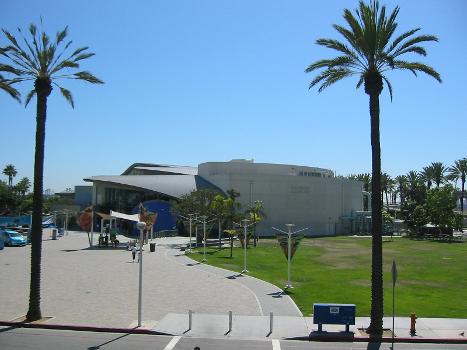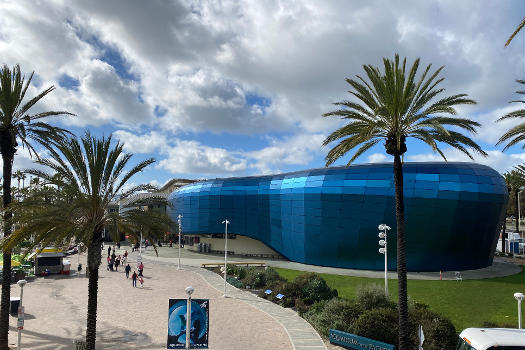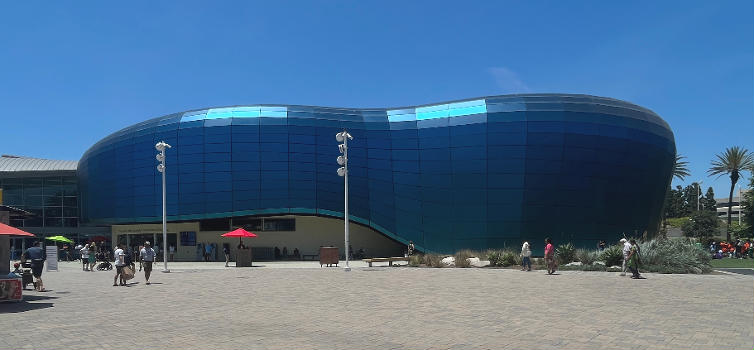General Information
| Completion: | 1998 |
|---|---|
| Status: | in use |
Project Type
| Function / usage: |
Aquarium |
|---|
Location
| Location: |
Long Beach, Los Angeles County, California, USA |
|---|---|
| Coordinates: | 33° 45' 44" N 118° 11' 49" W |
Technical Information
There currently is no technical data available.
Excerpt from Wikipedia
The Aquarium of the Pacific (formerly the Long Beach Aquarium of the Pacific) is a public aquarium on a 5-acre (20,000 m²) site on Rainbow Harbor in Long Beach, California, United States. It is situated across the water from the Long Beach Convention Center, Shoreline Village, and the Queen Mary Hotel and Attraction.
The Aquarium sees 1.5 million visitors a year and has a total staff of about 1,875 people, including more than 1,500 volunteers and about 375 employees. It is a 501(c)(3) non-profit aquarium.
The Aquarium is an accredited member of the Association of Zoos and Aquariums (AZA).
Exhibits
The Aquarium features a collection of over 11,000 animals representing over 500 different species in exhibits ranging in size and capacity from about 5,000 to 350,000 gallons. Exhibits introduce the inhabitants and seascapes of the Pacific, while also focusing on specific conservation messages associated with each region. The Pacific Ocean is the focus of three major permanent galleries, sunny Southern California and Baja, the frigid waters of the Northern Pacific and the colorful reefs of the Tropical Pacific.
Southern California & Baja Gallery
The Southern California & Baja Gallery features the varied habitats of this region. The first exhibit is the 142,000-US-gallon (540,000 l) three-story Blue Cavern tank, which houses animals that live in the waters surrounding nearby Catalina Island. Next is the Amber Forest exhibit, which replicates a Giant kelp forest with Garibaldi, California scorpionfish, and other representative organisms. The Gulf of California exhibit houses Cortez rainbow wrasse, Mexican lookdowns, Porcupine fish, and others. Other areas of the gallery include the 211,000-US-gallon (800,000 l) Seal and Sea Lion Habitat, Ray Touch Pool, and Shorebird Sanctuary.
Northern Pacific Gallery
The Northern Pacific Gallery focuses on organisms from the Bering Sea. Exhibits include the Sea Otter Habitat, home to southern sea otters; the giant Pacific octopus tank; and Diving Birds, where puffins and auklets live. Other species on display include Japanese spider crabs, jellyfish, and sea anemones.
Tropical Pacific Gallery
The Tropical Pacific Gallery exhibits animals off the coast of the islands of Palau and has the aquarium's largest tank, the 350,000-US-gallon (1,300,000 l) Tropical Reef Habitat. This tank houses olive ridley sea turtles, zebra sharks, and many other species. Elsewhere in the Gallery are big-belly seahorses, leafy seadragons, weedy seadragons, and sea kraits.
Explorer's Cove
The Aquarium's main outdoor area, Explorer's Cove, encompasses the Shark Lagoon and Lorikeet Forest.
Shark Lagoon
This 10,000-square-foot (930 m²) exhibit area houses over 150 sharks and rays. The main tank houses larger spec rays, whitetip reef sharks, nurse sharks, and sand tiger sharks, while the more docile Bamboo and epaulette sharks live in the three touch pools.
Lorikeet Forest
The Lorikeet Forest walk-through aviary covers 3,200 square feet (300 m²) and houses five subspecies of rainbow lorikeet as well as the violet-necked lory. Guests may feed them small amounts of nectar for a fee.
June Keyes Penguin Habitat
This exhibit for the Magellanic penguin opened in May, 2012. An underwater crawl-in space allows guests to view the penguins from within the tank.
Other attractions
In spring 2010, the Aquarium opened a new 4,700-square-foot (440 m²) Earth-Friendly Garden on its front lawn. The garden features California native and drought-resistant plants, as well as a very efficient irrigation system, to show part of the solution to Southern California's ongoing water shortage problems.
Activities
Activities of the Aquarium of the Pacific employees and volunteers extend far beyond exhibits. The diverse marine science and conservation ventures include: breeding and conservation programs for endangered marine animals and habitats; housing of unreleasable seals, sea lions, and sea otters from local care centers and marine parks; beach and habitat cleanups; a variety of green business practices; and continuing efforts to educate visitors on the importance the ocean, its threats, and conservation, including the hazards of marine pollution, over-harvesting, habitat destruction and global climate change. One example is a trashion festival with works by Marina DeBris educating about ocean pollution.
The Aquarium of the Pacific is also home to many cultural events throughout the year, such as the Pacific Islander Festival in the summer, the Moompetam Festival in the fall, special treats for the animals at Christmas, the Festival of Human Abilities in January, and the African Heritage Festival in February.
Architecture
The Aquarium architecture is inspired by the towering, breaking waves of the Pacific and mirrors the fluid and dynamic temper of the ocean. Kajima International, developers of the world’s most critically acclaimed and technologically advanced aquariums, was the developer of the Aquarium of the Pacific and architects included the Los Angeles office of Hellmuth, Obata & Kassanbaum and Esherick Homsey Dodge and Davis of San Francisco. Construction was a joint venture of Turner Construction Company and Kajima International. Construction of the Aquarium was completed on June 20, 1998 when the Aquarium opened to the public.
Text imported from Wikipedia article "Aquarium of the Pacific" and modified on July 23, 2019 according to the CC-BY-SA 4.0 International license.
Participants
Relevant Web Sites
- About this
data sheet - Structure-ID
20009282 - Published on:
14/05/2003 - Last updated on:
02/09/2024







